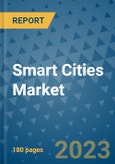The analyst predicts significant growth in the global smart cities market, driven by breakthrough developments and growing urbanization. Smart cities leverage information and communication technologies to optimize resource management, promote economic development, and enhance the quality of life for citizens. The market is expected to exceed a valuation of US$1 trillion by 2030, owing to the increasing acceptance of technologically advanced solutions and the need to induce economic growth and improve the quality of life.
Key Report Findings
- The smart cities industry currently values more than US$500 Bn and is projected to surpass a trillion-dollar revenue by 2030.
- Artificial Intelligence (AI) and machine learning (ML) are expected to make significant advancements in the smart cities market.
- North America is expected to lead the global smart cities market, leveraging its first mover's advantage.
- IBM Corporation, Cisco Systems, Inc., AT&T Intellectual Property, General Electric, and Ericsson are among the top five companies in the global smart cities market.
Growth Drivers
AI and ML technologies have made significant contributions to the development of smart cities. These technologies enable the collection and analysis of vast amounts of data, empowering systems to make intelligent decisions with minimal human intervention. They play a crucial role in areas such as traffic management, medical monitoring, video surveillance, and environmental monitoring, leading to effective smart city planning and progress.
Cutting-edge Technological Advancements
The smart cities market has witnessed significant advancements in emerging technologies, including AI, ML, cloud computing, IoT, and cybersecurity. These technologies have revolutionized connectivity within smart cities, transforming urban environments into smarter and more efficient spaces.
Growth Challenges
Privacy and security are significant concerns in the implementation of smart city projects, especially as the market relies heavily on IoT and central access points for data. Addressing these challenges requires a holistic approach from stakeholders to ensure the security and privacy of citizens using smart city services.
Challenges in Front of Legacy Telecom Infrastructure
The adoption of smart city solutions heavily relies on fast and reliable internet connectivity. In developing and underdeveloped nations with outdated telecom infrastructure, inadequate capacity and high latency of legacy systems pose challenges to the implementation of smart city solutions.
Overview of Key Segments
The healthcare industry is experiencing transformation driven by IoT applications. Smart healthcare solutions, including remote patient monitoring and automation of patient care workflows, are revolutionizing patient care and healthcare delivery.
Streamlining Utilities with Smart Metering and Meter Data Management Solutions
Smart metering and meter data management solutions are streamlining utility management by centralizing data collection and analysis, leading to enhanced operational efficiency and improved customer services.
Regional Segment
North America is expected to lead the global smart cities market, driven by technological advancements, digital transformation, and a well-established infrastructure for the information and communication technology industry.
Leading Industry Participants
Prominent players in the global smart cities market include IBM Corporation, Cisco Systems, Inc., AT&T Intellectual Property, General Electric, Ericsson, Huawei Technologies Co. Ltd., Hitachi, Ltd, Intel Corporation, Microsoft Corporation, and Schneider Electric.
Table of Contents
Companies Mentioned
- ABB Limited
- AGT International
- AVEVA Group plc.
- Cisco Systems, Inc.
- Ericsson
- General Electric
- Honeywell International Inc.
- Huawei Technologies Co., Ltd.
- Microsoft Corporation
- Oracle Corporation
- Osram Gmbh
- SAP SE
- Schneider Electric SE
- Siemens AG
- Telensa
Methodology

LOADING...








